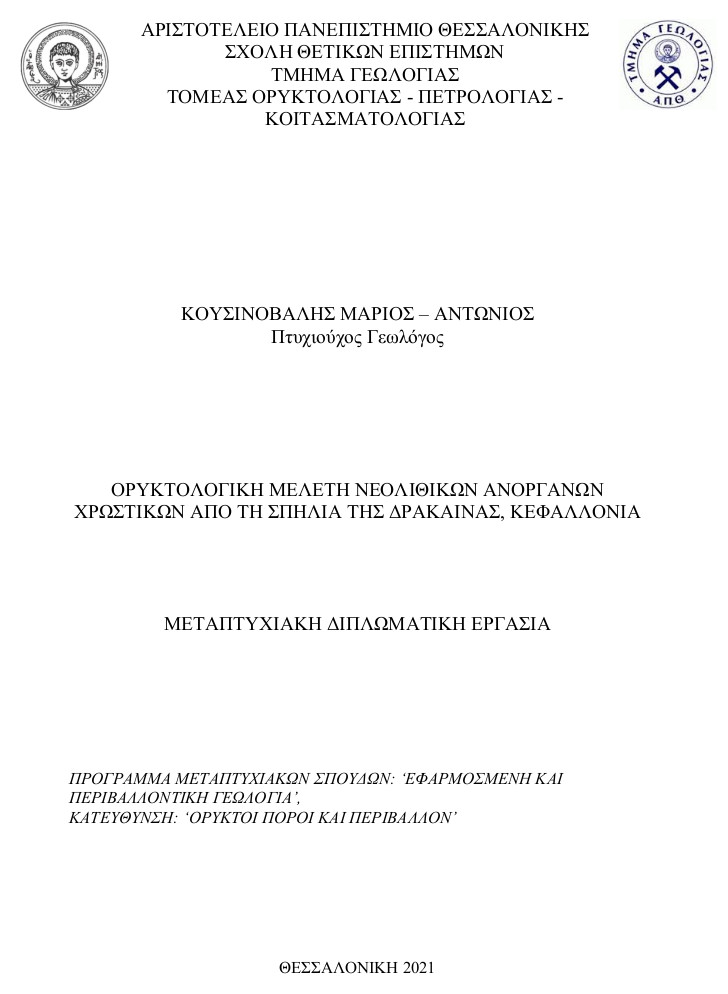
Ορυκτολογική μελέτη νεολιθικών ανόργανων χρωστικών από τη σπηλιά της Δράκαινας, Κεφαλλονιά = Mineralogical study of neolithic inorganic pigments from the Drakaina cave, Kephallonia.
Περίληψη
Since the rise of the humankind, the main source for pigment preparation, were various natural resources, mainly minerals. These sources have been used for the creation of marvelous frescoes, but also for the decoration of artefacts, usually used for rituals, but also for everyday objects as well. This practice can be spotted in Greece, but also on a global scale. The current thesis deals with the pigments used in the frescoes found inside the cave of Drakaina, in the island of Cephallonia, Greece, which date back to Neolithic times. Specifically, the goal of this master is the identification of the minerals responsible for the colors of three different pigments. With the use of Fourier Transformed Infrared Spectroscopy (FTIR) Scanning Electron Microscopy (SEM) coupled with an Energy Dispersive Spectrometer (EDS) and X-ray Diffraction (XRD) it was observed that the white pigment owes its color to a mixture of quartz, amorphous silica and calcite, the brown pigment owes its color to goethite and the red pigment to hematite.
Πλήρες Κείμενο:
PDFΑναφορές
Ξενόγλωσση βιβλιογραφία
Bugoi R., Constantinescu B., Pantos E., Popovici D. (2008). Investigation of Neolithic ceramic pigments using synchrotron radiation X-ray diffraction. Powder Diffraction, 23(3), 195-199.
Chalmin E., Vignaud C., Salomon H., Farges F., Susini J., Menu M. (2006). Minerals discovered in paleolithic black pigments by transmission electron microscopy and micro-X-ray absorption near-edge structure. Appl. Phys. A, 83, 213-218.
Guineau B., Lorblanchet M., Gratuze B., Dulin L., Roger P., Akrich R., Müller F. (2001). Manganese black pigments in prehistoric paintings: the case of the black frieze of Pech Merle (France). Archaeometry, 43, 211-225.
He L., Wang N., Zhao X., Zhou T., Xia Y., Liang J., Rong B. (2012). Polychromic structures and pigments in Guangyuan Thousand-Buddha Grotto of the Tang Dynasty (China). Journal of Archaeological Science, 39(6), 1809-1820.
Hejl E. and Tippelt G. (2005). Prehistorical pigment mining on Santorini’s neighboring island Anafi (Cyclades, Greece). Austrian Journal of Earth Sciences, 98, 22-33.
Karkanas, P. and Stratouli G. (2009). Neolithic lime plastered floors in Drakaina Cave, Kephalonia Island, Western Greece: Evidence of the significance of the site. The Annual of the British School at Athens, 103, 27-41.
Marey Mahmoud H.H. (2011). A preliminary investigation of ancient pigments from the mortuary temple of Seti I, el – Qurna (Luxor, Egypt). Mediterranean Archaeology and Archaeometry, 11, 1, pp. 99‐106.
Melfos V. and Stratouli G. (2016). Raw material and provenance identification of Late Neolithic and Chalcolithic chert artefacts from
Drakaina cave, Cephalonia, through petrographic and geochemical analysis. (2016). In P. Elefanti, N. Andreasen, P. Nick Kardulias and G. Marshall (eds.), Lithics Past and Present. Perspectives on Chipped Stone Studies in Greece, Studies in Mediterranean Archaeology, Aströms Förlag, Uppsala, 121-140, 2016.
Melfos V., Stratouli G., Voudouris P. (2020). Characterization of stone artifacts from the Middle and Late Neolithic to the Chalcolithic deposits of Drakaina Cave, Kephalonia, Ionian Islands: a mineralogical – geochemical approach for determination of local and “exotic” raw materials and their sources. Archaeological and Anthropological Sciences, 12, 65, 28 p.
Ospitali F., Smith D., Lordlanchet M. (2006). Preliminary investigations by Raman microscopy of prehistoric pigments in the wall‐
painted cave at Roucadour, Quercy, France. Journal of Raman Spectroscopy, 37, 1063-1071
Perdikatsis V. and Brecoulaki H. (2008). The use of red and yellow ochres as painting materials in ancient Macedonia. In Y. Facorellis, N. Zacharias & K. Polikreti (eds), Proceedings of the 4th Symposium of the Hellenic Society for Archaeometry, Αthens, 28-31 Μay 2003, BAR International Series 1746, Oxford: Archaeopress, 559-567.
Stratouli G., Sarpaki A., Ntinou M., Kotjabopoulou E., Theodoropoulou T., Melfos V., Andreasen N.H., Karkanas P., Touchais G., Laffineur P., Rougemont F. (2014). Dialogues between bioarchaeological, geoarchaeological and archaeological data: Approaches to understanding the Neolithic use of Drakaina cave, Cephalonia island, Western Greece. Aegaeum 37, 23-32.
Stratouli G. and Melfos V. (2008). Exchange networks in the Neolithic of Greece: Gabbro and Talc objects from Drakaina cave, Cephalonia island, Western Greece. In Y. Facorellis, N. Zacharias & K. Polikreti (eds), Proceedings of the 4th Symposium of the Hellenic Society for Archaeometry, National Hellenic Research Foundation, Athens, 28-31 Μay 2003, BAR International Series 1746, Oxford: Archaeopress, 381-387.
Sotiropoulou S., Perdikatsis V., Birtacha K., Apostolaki C., Devetzi A. (2012). Physicochemical characterization and provenance of coloring materials from Akrotiri – Thera in relation to their archaeological context and application. Archaeol. Anthropol. Sci., 4, 263-275
Ελληνική βιβλιογραφία
Καπετανίδης Ν. (2005). Χρώματα ζωγραφικής και αρχιτεκτονικής. Ιστορική αναδρομή – Χημεία χρωμάτων. Εκδόσεις Ζήτη, σ. 303.
Νικοπούλου Μ. (2019). Βασικά στοιχεία γεμολογίας και ανάλυση δειγμάτων αχάτη και μπροχαντίτη από την περιοχή Ξάνθης – Αλεξανδρούπολης. Πτυχιακή εργασία, Αριστοτέλειο Πανεπιστήμιο Θεσσαλονίκης, σ. 108.
Παπαλουκά Ε. Ζ. (2021). Εφαρμογή αναλυτικών τεχνικών σε φωτογραφίες των αρχών του 20ου αιώνα από το αρχείο της οικογένειας Μέλφου στη Θεσσαλονίκη. Μεταπτυχιακή Διπλωματική Εργασία, Αριστοτέλειο Πανεπιστήμιο Θεσσαλονίκης, σ. 77.
Διαδικτυακές πηγές
• https://myworldofcolour.wordpress.com/2010/04/24/the-characteristics-of-colour/
• https://www.eett.gr/opncms/opencms/EETT/Electronic_Communications/Antennas_EMR/health/EMRadiation/EMRadiation/
• https://intlvac.com/News-Resources/ArticleID/17/Seeing-In-The-Dark-and-Other-Unique-Infrared-Applications
Εισερχόμενη Αναφορά
- Δεν υπάρχουν προς το παρόν εισερχόμενες αναφορές.
